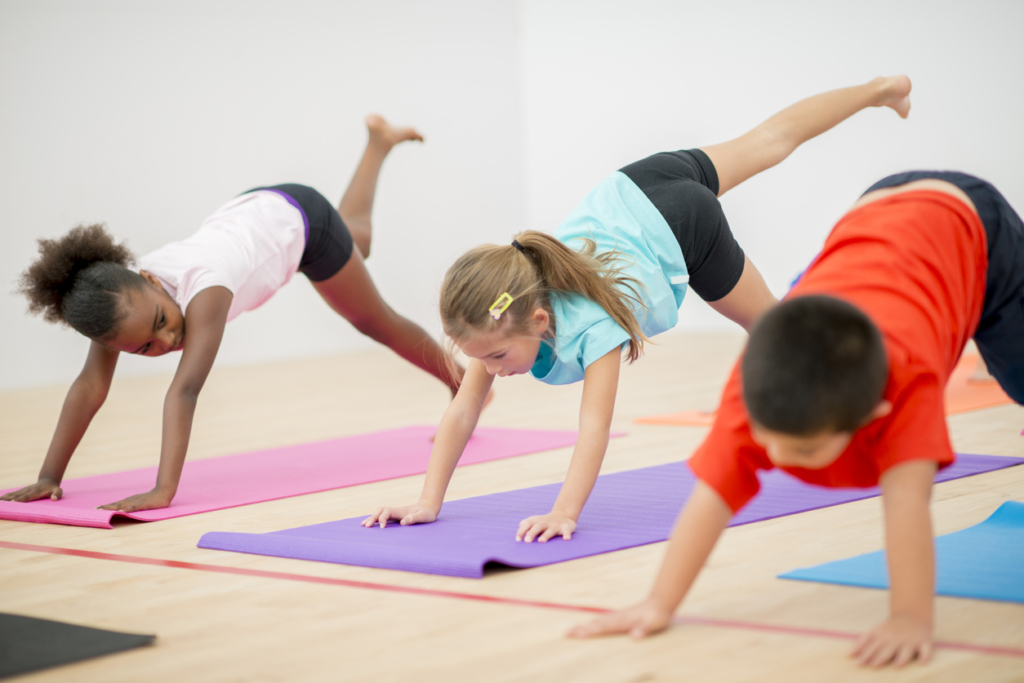Learning happens in all contexts of our lives, not just when learners are in a school building. In exploring other contexts for learning, like yoga, we can encourage the development of multiple intelligences—a diverse strength profile that is required in today’s complex world.
Alison Babula, Occupational Therapist, Certified Hand Therapist, and Power Flow Yoga instructor
The balance between motion and stillness is a basic, yet powerful, principle of yoga and yogic philosophy. In practice, it invites the individual to find a deeper connection to who they are as a human being. And, in the context of education, it can deeply connect young people to who they are as learners.
Yoga, as a conduit for accessing this equilibrium, can enable young people to cultivate the myriad physical and mental “intelligences”—ways of acquiring and applying knowledge about ourselves—that unleash them to fulfill their unique potential as multidimensional and nimble learners.
Though drawing a connection between yoga and education transformation may feel like a stretch, gaining a basic understanding of its foundational principles will immediately reveal yoga as a source of liberatory practice that unlocks boundless possibilities.
The 8 Limbs of Yoga
Traditionally, yogi’s speak of the “8 Limbs” of yoga—a name that comes from the Sanskrit term Ashtanga. The “8 Limbs” include: Yama (attitudes toward our environment), Niyama (attitudes toward ourselves), Asana (physical postures), Pranayama (restraint/expansion of the breath), Pratyahara (withdrawal of the senses), Dharana (concentration), Dhyana (meditation), and Samadhi (complete integration).
Using all eight limbs, yoga is designed to recognize and respond to fluctuations of the mind. For example, when one encounters fear-avoidance and catastrophization, using the physical body in asana is one tool we can use to self-regulate.
These eight limbs, when applied with intention, can unlock the potential for an individual to connect more intimately with their environment, build self-awareness, enhance concentration skills, and more.
But how does one build this elevated intelligence of body and mind and apply it to their learning?
Applying Yoga to Reimagine Intelligence
Since at least the turn of the 20th-century, Western societies have attempted to quantify and categorize human intelligence by a single quantitative measure. One of the most popular measures is the Intelligence Quotient (IQ): a total score derived from a set of standardized tests or subtests that often solely focus on logic and mathematics. The IQ test was the standard test for intelligence until the 1970’s when research began emerging that exposed its broad assumptions, particularly that the intelligence of a human being could be measured by a single test and a single quantitative score.
The test fails to account for the many ways people learn, including through motion, listening, touch, and reflection. I’ve witnessed yogis who’ve dropped out of school thrive in the environment of a power flow yoga class—where, guided by the rhythm of their own breath and movement, they awaken to new intelligences each time they return to their practice.
I’m reminded of Joe, who dropped out of school to become an HVAC mechanic. Joe enrolled in a weekly yoga practice to add another element to his exercise routine but quickly discovered that it offered him so much more—access to new learning pathways. His knowledge of mechanics allowed him to quickly master a technically complex category of poses: inversions—handstands and headstands—that require patience, proper alignment, and balance. Joe, who once told me that, “School just wasn’t his thing,” excelled at intuitively applying concepts from his chosen profession to explore a new discipline. And, in the process, gained a new understanding of the limits of his mind and body.
He was employing a concept that education researcher Dr. Howard Gardner developed in the late 1970s: Multiple Intelligence theory, detailed in his book Frames of Mind: The Theory of Multiple Intelligences. When channeled as education tools, several of these intelligences—including spatial, bodily-kinesthetic, interpersonal, and intrapersonal—can powerfully support our learning and build a bridge to greater self-awareness.
Using the Intelligences to Find Your Learning Frequency
Intrapersonal Intelligence
Intrapersonal intelligence, also called self-intelligence, aligns with the Niyama limb of yoga (attitudes toward oneself) and forms the basis for discovering your strengths and weaknesses. This is the attunement to one’s feelings, anxieties, fears, goals, and capacity to plan and act without restraint. This is where I have found yoga to be most impactful in my life and on my learning.
As someone with generalized anxiety disorder, yoga has helped me recognize my anxieties and triggers and soothe the fears they manifest. As a former runner, I found yoga by accident while searching for a complement to my running practice. What I discovered along the way was that it was not only a workout, but also a work-in.
My yoga practice was not only getting my heart pumping, muscles working, and sweat flowing, it gave me the space to focus, for an hour each day, on controlling my breath and movement. Through my practice, I was able to let go of my day and all the anxiety and fear that had built up.
Now, as a dedicated yogi, I know I can rely on specific breathing techniques and postures that help to calm the nervous system if I get overwhelmed while learning any new task. When an individual is anxious, research shows that it impacts their working memory in two significant ways: 1) it makes it harder to commit information to long-term memory, and 2) it inhibits the ability to work and think with clarity of mind.
Making yoga a regular practice for learners can start with dedicating time at the start of the day to the mastery of balancing inhalation and exhalation. This ability to quiet the mind and to self-regulate empowers learners to navigate the noise in their head and focus on the moment, amplifying their capacity to become attuned to the interests that spark joy in them or re-center themselves through regular pauses.
Spatial Intelligence
Spatial intelligence is the ability to conceptualize local forms of space (as a chess player can) or manipulate large-scale spatial arrays (as a pilot can). This is aligned with the Yama limb of yoga (awareness of your own environment). Yoga can enhance this type of intelligence through the act of adapting your practice to different settings—being in a small room versus being outside in the elements offer different, but equally invigorating, experiences. This can be understood through visualizing the position of the body in relation to the floor/wall/ceiling, as opposed to outside where you can create your own boundaries and juxtapositions. This shifts your view of your environment and your relationship to it.
Yoga can be a tool to use when we want to encourage young learners to be connected to the earth, rather than focusing solely on academic benchmarks.
Bodily-kinesthetic intelligence
Bodily-kinesthetic intelligence is the ability to use one’s whole body or part of one’s body to evoke creativity or solve a problem. This aligns with the Asana limb of yoga but also incorporates Dharana (concentration) and Dhyana (meditation).
The application of yoga to this particular type of intelligence is intuitive. When we are flowing through a yoga practice, we are emulating the shape the instructor has performed, or we are translating words into motion. We are literally using our bodies to learn. Over the years, I’ve seen this intelligence blossom in my yogis. Their intuitive knowledge of their bodies’ capabilities is astounding and, the deeper their practice of meditation and mindfulness, the more profound their physical abilities become. Gaining this type of knowledge of one’s own body and what it is capable of promotes confidence and self-esteem. Conceptualizing your body in space, and being comfortable “taking up space,” is something I have heard yogis comment on. Knowing where your body ends and the earth begins gives a sense of grounding and a sense of belonging. Those who were shrinking violets are now more comfortable expressing themselves and freely moving in different environments.
Interpersonal Intelligence
Finally, interpersonal intelligence—sometimes called social intelligence—is easily honed in yoga class. When participating in a class, one can observe other individuals’ feelings and moods, then reflect on those observations. Here the limbs of concentration and awareness of one’s environment (Yama and Dharana) are employed. Being among a group of people, immersed in a shared experience and moving in sync, can be a very powerful tool for bonding and developing interpersonal relationships. It’s also a great way to discover that a shared experience can impart different lessons or inspire different awakenings for each individual. It can reveal that life, like learning, is an authentically individual experience, with visitors along the way who show up to guide us.
Yoga as An Act of Liberation
The yogi’s eight-limbed holistic approach to teaching yoga mirrors the learning implications of Multiple Intelligence. That is: education should be geared toward the individual, should serve the individual, and should be experienced in a number of ways. Learning happens in all contexts of our lives, not just when learners are in a school building. In exploring other contexts for learning, like yoga, we can encourage the development of multiple intelligences—a diverse strength profile that is required in today’s complex world.
Even though I discovered yoga by accident, it’s had a profound impact on my ability to be a multidimensional learner. As I embark on the next steps of my Occupational Therapy (OT) career by entering a doctoral program, I feel empowered to utilize different intelligences to absorb, investigate, and apply new information. I no longer feel constrained by conventional learning methods and now choose to complement my studies with music, nature, movement, collaboration, and individual educational pursuits.
Over the years, I have increased my confidence, intrapersonal and interpersonal skills, and overall self-regulation skills. My bodily intelligence is now enhanced, having now become more aware of my movement and how my daily postures influence my emotions and sense of self. My spatial intelligence, while already a strength, has been improved and translates into my ability to teach Kinesiology, as an occupational therapist, with more ease. I also no longer hold myself to the standards set by the traditional IQ test. Rather, I see myself as a multifaceted learner with complex needs, diverse interests, and unique capabilities.
When given the opportunity to simply be and think, a learner can develop the ability to see and embody multiple intelligences. They can work on identifying their natural abilities and talents, while recognizing areas in need of improvement.
In order to achieve Samadhi (complete integration), one needs to have ideas, concepts, theories, and skills presented and taught in different ways. Through these different types of teachings, we deepen our knowledge of ourselves and of our learning abilities. Yoga becomes a gateway to greater learning because our learning becomes an embodiment of who we are on the deepest level and who we are yet to become.

